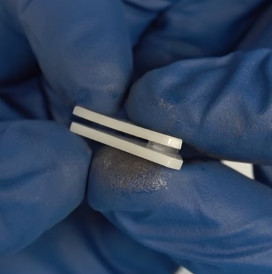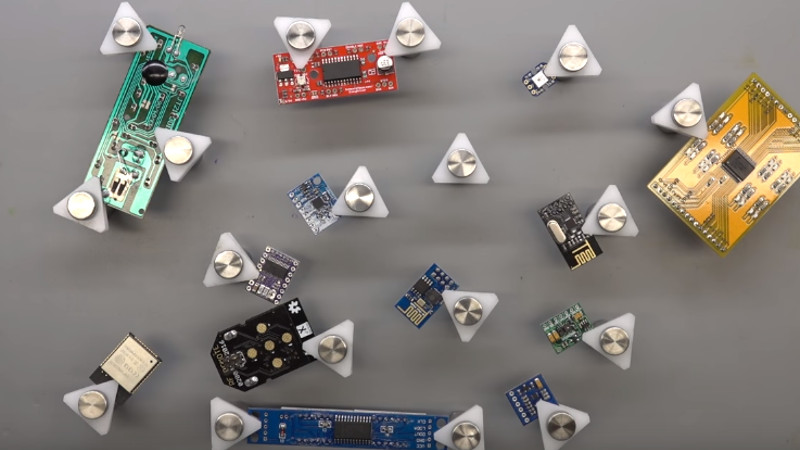[Proto G] recently wrote in to share a very slick way of keeping tabs on all the tiny PCBs and devices that litter the modern electronics workbench. Rather than a big bulky PCB vise for each little board, he shows how to make tiny grippers with magnetic bases for only a couple bucks each. Combined with a sheet metal plate under an ESD mat, it allows him to securely position multiple PCBs all over his workspace.
 The key to this hack is the little standoffs that are usually used to mount signs to walls. These already have a clamping action by virtue of their design, but the “grip” of each standoff is improved with the addition of a triangular piece of plastic and rubber o-ring.
The key to this hack is the little standoffs that are usually used to mount signs to walls. These already have a clamping action by virtue of their design, but the “grip” of each standoff is improved with the addition of a triangular piece of plastic and rubber o-ring.
With the gripping side of the equation sorted, small disc magnets are glued to the bottom of each standoff. With a suitable surface, the magnets are strong enough to stay upright even with a decently large PCB in the jaws.
An especially nice feature of using multiple small vises like this is that larger PCBs can be supported from a number of arbitrary points. It can be difficult to clamp unusually shaped or component-laden PCBs in traditional vises, and the ability to place them wherever you like looks like it would be a huge help.
We’ve recently covered some DIY 3D printed solutions for keeping little PCBs where you want them, but we have to say that this solution looks very compelling if you do a lot of work on small boards.
















Hmmm where would I find those plastic clip?
guitar picks
A thin plastic kitchen cutting board should provide enough material for as many clips as you want.
just print 50 of them
I’m sure it’s also cheap and quick to lasercut a ton of those
Just in case someone might find this useful: I sometimes make a crumpled paper hat for my finger so I can hold/push hot components while soldering. It’s just insulating enough for my needs.
Now I guess there are commercial solutions too, but the point is that heat-resisting a finger can be quite handy in soldering – and hot-gluing too come to think of it.
I’ve used a ceramic thimble for the same purpose before.
Paper sounds like a better solution. I’ll keep it in mine. Thanks!
The only problem i’ve had so far with every 3D printed plastic PCB vise or soldering helper: As soon as you need to do some rework, they all melt away or get soft enough to let go of the boards… Maybebetter to lasercut them from spring steel and coat in Kapton or another heat tolerant insulation material.
You can use a piece of circuit board
Good idea! You don’t even need insulation if you’re just using them for rework.
Perhaps use FR4 material from some scrap PCB could work?
Let’s go further and add test-points to the tips of these triangular bits of circuit board, with something on the other end to clip a cable to.
https://en.m.wikipedia.org/wiki/File:NdFeB_corrosion.jpg
I’m not sure why he does this, but the video shows him sanding the surface of these Neodymium magnets. This is a bad idea. Withought the protective plating, the magnets will oxidize and lose their magnetization.
From Wikipedia:
“This type of corrosion can cause serious deterioration, including crumbling of a magnet into a powder of small magnetic particles, or spalling of a surface layer. This vulnerability is addressed in many commercial products by adding a protective coating to prevent exposure to the atmosphere.”
https://upload.wikimedia.org/wikipedia/commons/a/a9/NdFeB_corrosion.jpg
It is not a bad idea. I did not sand off the plating, I just scratched the surface enough to improve the glue bond. It is even recommended by a company that only sells magnets https://www.kjmagnetics.com/blog.asp?p=sticky-business-how-to-glue-neodymum-magnets